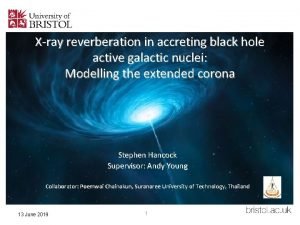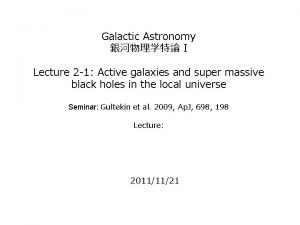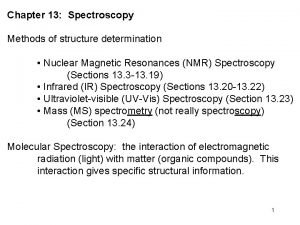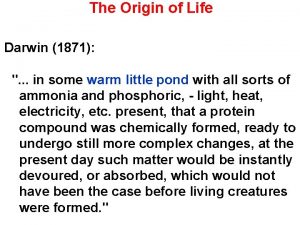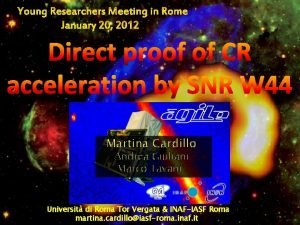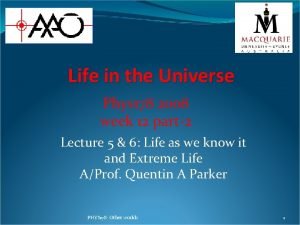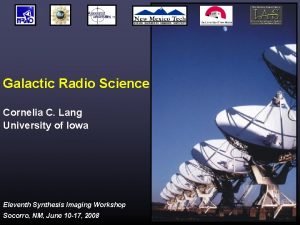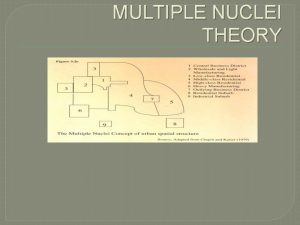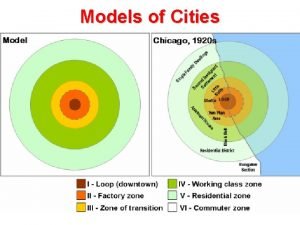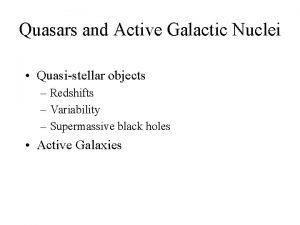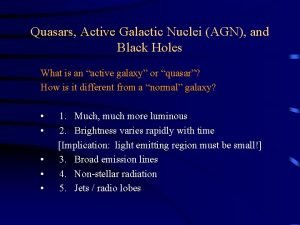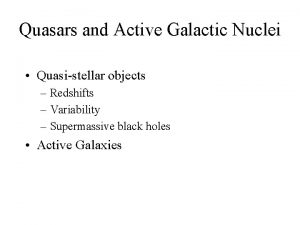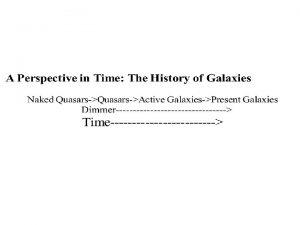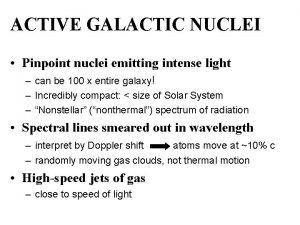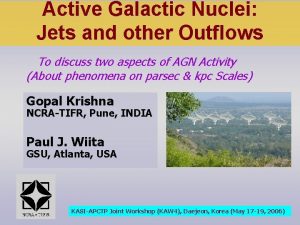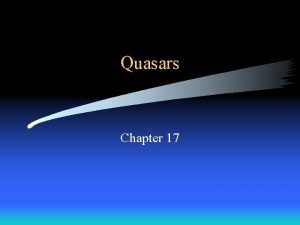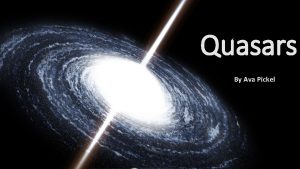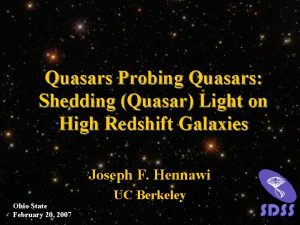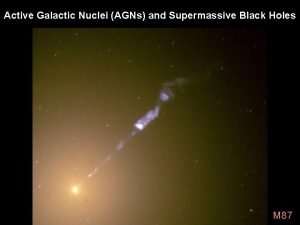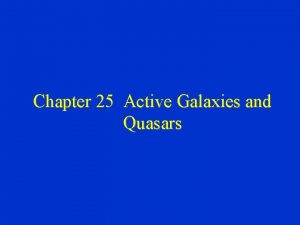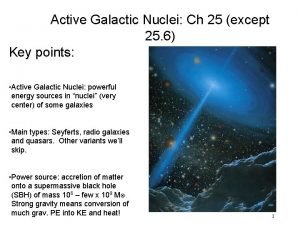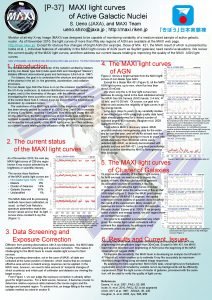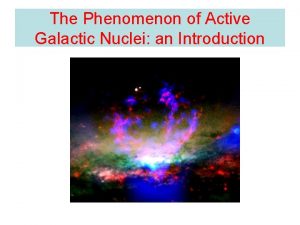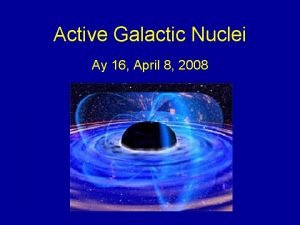15 4 Quasars and Other Active Galactic Nuclei



































- Slides: 35

15. 4 Quasars and Other Active Galactic Nuclei • Our Goals for Learning • What are quasars? • What is the power source for quasars and other active galactic nuclei? • Do supermassive black holes really exist?

What are quasars?

If the center of a galaxy – the galaxy’s nucleus – is unusually bright we say that the galaxy hosts an active galactic nucleus or AGN. Quasars are the most luminous examples of AGN. Active Nucleus and optical jet in M 87

The highly redshifted spectra of quasars indicate large distances From brightness and distance we find that luminosities of some quasars are more than a trillion times the Sun’s Variability shows that all this energy comes from region smaller than the solar system

What can you conclude from the fact that quasars usually have very large redshifts? 1. They are generally very distant. 2. They were more common earlier in the universe. 3. Galaxy collisions might switch them on. 4. Nearby galaxies might harbor quasar remnants. 5. All of the above. 6. None of the above.

Galaxies around quasars sometimes appear disturbed by collisions Quasars fueled by gas concentrated in nucleus by galaxy collisions

Radio galaxies contain active nuclei generating vast, straight jets of plasma. The plasma (ionized gas) emits radio waves that we can detect.

Jets of radio galaxies moving through gas in galaxy clusters can be deflected

What is the power source for quasars and other active galactic nuclei?

Accretion of gas onto a supermassive black hole appears to be the only way to explain all the properties of quasars

Energy from a Black Hole • Matter falling towards a black hole gains speed (turns gravitational potential energy into kinetic energy)

Energy from a Black Hole • Matter falling towards a black hole gains speed (turns gravitational potential energy into kinetic energy) • Friction in an accretion disk turns kinetic energy into thermal energy (heat & light)

Energy from a Black Hole • Matter falling towards a black hole gains speed (turns gravitational potential energy into kinetic energy) • Friction in an accretion disk turns kinetic energy into thermal energy (heat & light) • Hot disk emits optical and ultraviolet light

Energy from a Black Hole • Matter falling towards a black hole gains speed (turns gravitational potential energy into kinetic energy) • Friction in an accretion disk turns kinetic energy into thermal energy (heat & light) • Hot disk emits optical and ultraviolet light • Matter spiralling into a black hole can radiate energy equal to 10 -40% of the matter's mass-energy E = mc 2. . . much more efficient than fusion (1% of mc 2)

An active galactic nucleus (left-hand spot) can eject a blob of plasma (right-hand spot) moving at nearly the speed of light Speed of ejection suggests that a black hole is present

Jets are thought to come from twisting of magnetic field in the inner part of accretion disk

Jets may be produced only when black hole is rapidly spinning (not all black holes spin rapidly, so not all quasars have jets).

Radio galaxies don’t appear as quasars because dusty gas clouds block our view of accretion disk (but some radio quasars do exist)

Quasar feedback • Jets and other feedback from quasars affect the host galaxy • Gas is heated, ionized, pushed away from nucleus, eventually stopping quasar from shining and galaxy from forming stars • To do all that in a more massive galaxy requires a more massive black hole


Quasar feedback • Jets and other feedback from quasars affect the host galaxy • Gas is heated, ionized, pushed away from nucleus, eventually stopping quasar from shining and galaxy from forming stars • To do all that in a more massive galaxy requires a more massive black hole • Quasar can even affect the surrounding galaxy cluster, if the host galaxy is in a cluster … see black hole animations

Do supermassive black holes really exist?

Orbits of stars at center of Milky Way stars indicate a black hole with mass of 4 million MSun

Orbital speeds and distances of gas orbiting in the center of M 87 indicate a black hole with mass of 3 billion MSun

Black Holes in Galaxies • Many nearby galaxies – perhaps all large ones – have supermassive black holes at their centers • These black holes seem to be dormant active galactic nuclei • All large galaxies probably passed through a active galactic nucleus stage earlier in time

What have we learned? • What are quasars? • Some galaxies have unusually bright centers which are called active galactic nuclei. • A quasar is a particularly bright active galactic nucleus. Quasars are generally found at very great distances, telling us that they were much more common early in the history of the universe, when galaxy collisions were more common.

What have we learned? • What is the power source for quasars and other active galactic nuclei? • Supermassive black holes are thought to be the power sources for active galactic nuclei. As matter falls into a supermassive black hole through an accretion disk, its gravitational potential energy is transformed into thermal energy and then into light with enormous efficiency.

What have we learned? • Do supermassive black holes really exist? • Observations of orbiting stars and gas clouds in the nuclei of galaxies suggest that all large galaxies may harbor supermassive black holes at their centers.

Activity 39, pages 139 -140: Superluminal (faster-than-light) motion in quasar jets? • A quasar ejects a blob of gas on day zero. • Blob travels at (13/14) times the speed of light • Light from blob on day zero heads towards Earth, but blob travels in a slightly different direction.

1. On day 14, the blob is at position C and the light that the blob emitted on day zero is located at: 1. 2. 3. 4. 5. 6. 7. 8. A B C D E F G H

2. On day 28, where is the light the blob emitted on day zero and day 14? 1. 2. 3. 4. 5. 6. Day zero light at E, Day 14 light at G Day zero light at G, Day 14 light at I Day zero light at H, Day 14 light at G Day zero light at F, Day 14 light at H Day zero light at H, Day 14 light at I Day zero and Day 14 light both at I

3. If the blob’s light from day zero (location F) is seen on Earth on day 10 million, the blob’s light from day 14 (location H) will be seen on Earth… 1. 2. 3. 4. 5. On Earth day 10 million and 1 On Earth day 10 million and 2 On Earth day 10 million and 13 On Earth day 10 million and 14

4. How far will the blob appear to move on the sky in those 2 days? 1. 2. 3. 4. 5. 6. 1 light-day 2 light-days 5 light-days 7 light-days 10 light-days 28 light-days

5. We know the blob is travelling at 13/14 ths of lightspeed, but from Earth it looks like the blob travels at an apparent speed of… 1. Lightspeed (1 light-day per day) 2. 2. 5 × lightspeed (2. 5 light-days per day) 3. 13 × lightspeed (13 light-days per day)

Apparent superluminal (faster-than-light) motion in quasar jets! • A quasar ejects a blob of gas on blob day zero. • Blob travels at 13/14 ths of the speed of light “c” • Light from blob on day zero heads towards Earth, but blob travels in a slightly different direction. • Blob moving slower than light almost in Earth’s direction almost catches up with the light it emitted earlier, so blob appears to move faster than light.
 Reverberation
Reverberation Active galactic nuclei
Active galactic nuclei Active galactic nuclei
Active galactic nuclei Nmr active and inactive nuclei
Nmr active and inactive nuclei Galactic headquarters map
Galactic headquarters map City model
City model Galactic empire vs combine
Galactic empire vs combine Weaknesses of the multiple nuclei model
Weaknesses of the multiple nuclei model Peripheral model
Peripheral model Galactic center radio transients
Galactic center radio transients Galactic habitable zone
Galactic habitable zone Galactic phonics ure
Galactic phonics ure Galactic cap review
Galactic cap review Martina cardillo
Martina cardillo Galactic habitable zone
Galactic habitable zone Galactic
Galactic Boolean operators
Boolean operators Primary vs secondary active transport
Primary vs secondary active transport Primary active transport vs secondary active transport
Primary active transport vs secondary active transport Types of repair
Types of repair Harris and ullman multiple nuclei model example
Harris and ullman multiple nuclei model example Multiple nuclei model
Multiple nuclei model Harris and ullman multiple nuclei model
Harris and ullman multiple nuclei model Hoyt sector
Hoyt sector Multi nuclei zone model
Multi nuclei zone model Chauncy
Chauncy How unstable atoms gain stability
How unstable atoms gain stability Multiple nuclei model example
Multiple nuclei model example Sprawl ap hug
Sprawl ap hug Nucleii cohleari
Nucleii cohleari Multiple nuclei model ap human geography definition
Multiple nuclei model ap human geography definition Location
Location Structures in limbic system
Structures in limbic system Reticular formation
Reticular formation Follicular nonhodgkins lymphoma
Follicular nonhodgkins lymphoma Concentric zone model zone of transition
Concentric zone model zone of transition
